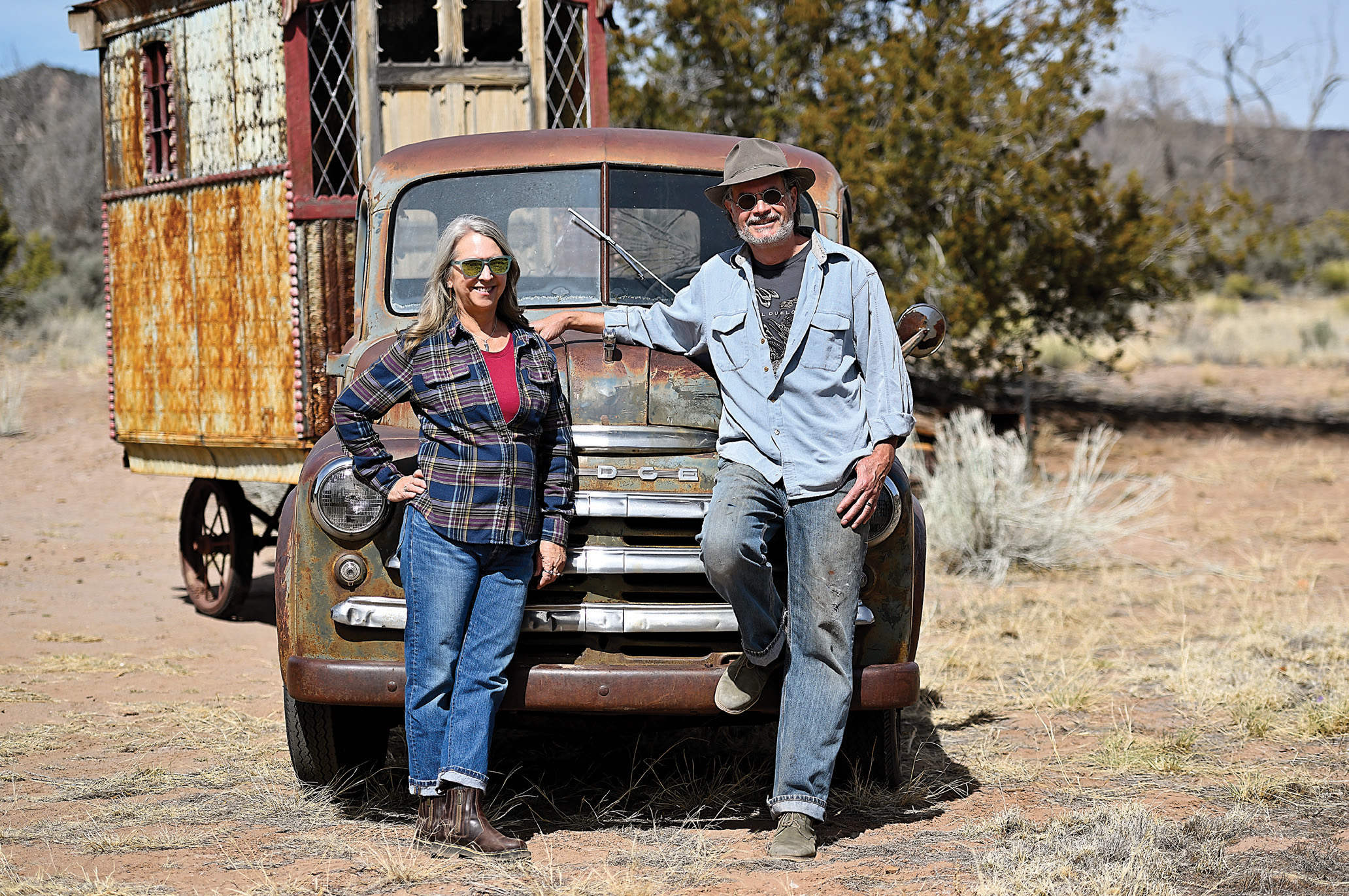
30 Apr IN THE STUDIO: A PAINTERLY LIFE IN THE LAND OF ENCHANTMENT
Jim Vogel was always known as the artist among his 11 sisters and brothers. As children, they’d be playing outside their home in Roswell, New Mexico, when an idea would pop into Jim’s head, and he’d run inside to craft his latest vision. Once, it was a cowboy riding an ostrich.
“I knew from the earliest age that I would become an artist,” he says. “I was always drawing.” Vogel’s expansive childhood imagination was encouraged, and at age 10, his parents gave him an oil painting set. “I loved the smell of oil paints when I opened the first tube.”

Vogel’s painting La Querencia will appear in his forthcoming group show at Manitou Galleries in Santa Fe. It explores the concept of Saint Francis reaching out to native birds from New Mexico.
Visits to his local museum, the Roswell Museum and Art Center in New Mexico (today the Roswell Museum), enhanced Vogel’s early desire to be an artist. There, he saw important paintings, was encouraged to take art lessons, and met great artists. During his visits, he admired works by Howard Cook, Georgia O’Keeffe, and Luis Jiménez. The museum’s significant collection also included paintings by important New Mexico Regionalists Henriette Wyeth and Peter Hurd, who lived nearby in Hondo Valley. Vogel remembers seeing the couple regularly in Roswell, which encouraged him in his artistic dreams.
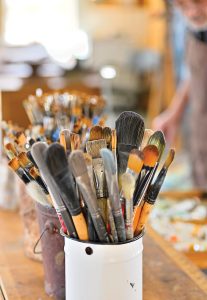
A series of containers holds the artist’s brushes; some are sable, and others have natural bristles. Vogel also uses synthetic brushes when called for.
As often happens, people questioned Vogel on his ability to support himself as an artist, so in college, he chose to study graphic arts as a more practical creative career path. While attending the Art Institute of Colorado in Denver, he met his wife, Christen, who was also a student. After graduating, the couple moved to Dallas, Texas, where Vogel worked as a graphic designer at Swieter Designs for five years and then as an art director.
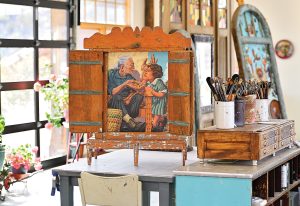
From the couple’s private collection, a painting titled Intercambio depicts a little girl exchanging a sunflower for her grandmother’s rosary.
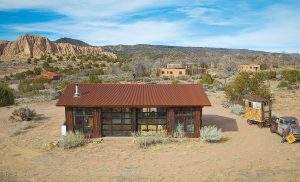
Vogel’s studio, built in 2020, is flanked by the Barranco Blanco sandstone cliff, and to the north, two glass panel garage doors face the landform. Windows around the studio allow plenty of natural light to filter through the space.
They returned to Denver in 1992, and Vogel worked for DeOlivera Creative and then at Vermillion Design in nearby Boulder, where Vogel was offered the opportunity to become a partner. With two children and another on the way, he knew it was the responsible thing to do, but after saying yes, angst set upon him. “It was New Mexicans and New Mexico that I pined for,” Vogel says.
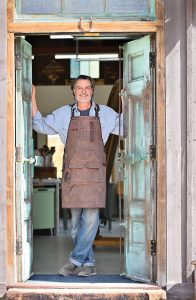
The artist welcomes visitors to the studio through its west-facing main entrance. The couple had purchased the antique copper-clad doors long before they knew what their purpose would be.
Ultimately, he returned to that deep longing from childhood and began painting what filled his mind. Vogel acquired gallery representation at Cline Fine Art in Santa Fe, and after a successful show in 1998 with two other young artists, Tony Abeyta and Francisco “Paco” Benitez, he felt the timing was right to segue out of commercial art and into fine art.
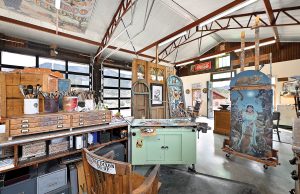
A work in progress on Vogel’s easel will have three-dimensional carvings when it is completed. It’s a companion piece to the painting in the background, and both works are 6 feet tall.
Vogel and Christen moved south in 1998, settling in the historic village of Dixon in Northern New Mexico, where they raised their family, built their careers, and have resided ever since. The Tiwa of nearby Picuris Pueblo first inhabited the area until Spanish colonists settled there in 1725. Today, the people who live there are full of colorful folklore, which inspires the artist, as does the landscape along the meandering Embudo Creek.
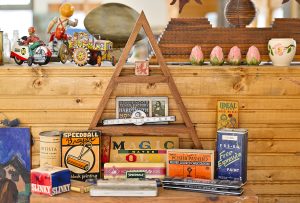
Some of the couple’s collectables gather in a corner and provide inspiration when needed. Antique art supplies and a collection of wind-up toys are among the treasured items.
Vogel admits he feels drawn to New Mexico Regionalism as an art style based on his love of the state’s citizens, artistic history, and landscapes. “Outside of New Mexico Regionalism, I was most influenced by the works of Thomas Hart Benton and Grant Wood,” he says.
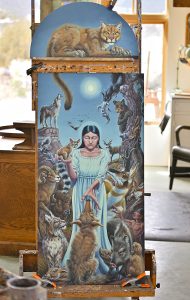
Sueños de Los Animales, or dreams of the animals, features mammals of New Mexico in a moonlight setting and includes a duende, a small mythical human-like creature. The painting will appear in the upcoming show at Manitou Galleries alongside La Querencia; both works will have identical frames created from arched antique windows with brass bars.
The figures in his paintings often have exaggerated features, leading some to call them Surrealist, but the artist doesn’t define his work with words. “Instead of staking a claim to any genre of art, I do what I want to in paint,” he says. “As an artist, I’m very selfish and always have been. I paint for myself first. I feel if I do it right, someone out there will like it.”
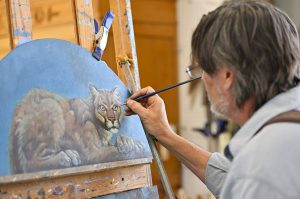
In the final stages of a painting, Vogel adds details, such as the flicker of light in a mountain lion’s eye.
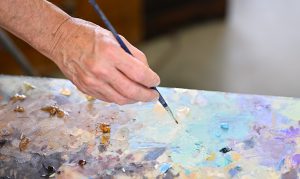
This taboret is a repurposed table covered with a glass top to scrape off dried paint. Often, the paint is left on the taboret until the completion of a painting so the artist can do touch-ups if necessary.
The artist gives credit to Christen for their success, as she creates the one-of-a-kind frames for his unusual-shaped canvases. “Christen is as much of an artist as I am in the way she creates framing from recycled materials. I’m looking at a walnut door over 150 years old with wormwood; it’s something you can’t fake — you can feel the authenticity in the wood,” Vogel says. “Christen’s frames not only hold paintings, but they also expand the meanings of my paintings. I love that a rusty piece of iron can help tell a story about a person, be it a farmer or a musician or any other individual.”
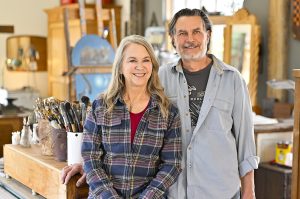
Christen and Jim met while they were students at the Colorado Institute of Art; they work side by side in their studio daily.
After many successful shows during Vogel’s 23 years at Blue Rain Gallery, his philosophy has proven true. As he looks ahead to the future and new ideas already taking shape, he remains grounded in the land that first inspired him: New Mexico. His career has been marked by formidable moments, including earning the 2016 New Mexico Governor’s Award for Excellence in the Arts. This spring, he participated in the 2025 Night of Artists at the Briscoe Western Art Museum in San Antonio, Texas; and, this summer, a retrospective of his work, Recuerdos Resurrected, takes place at Fechin Studio at the Taos Art Museum in Taos, New Mexico, from July 19 through September 7.
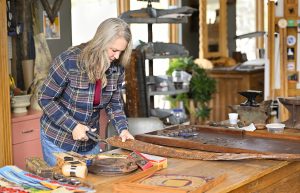
In preparation for Vogel’s solo show It’s Not All Fun and Games, Christen is cutting a piece of ornamental tin that will be part of a frame.
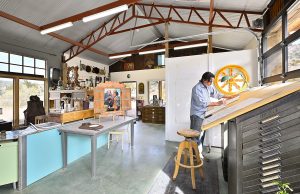
Vogel prefers to stand instead of sit when drawing. Cold-type cabinets, formerly used in a printing facility, provide the perfect height for his drawing table. The wooden stool, he says, is for times of contemplation.
Vogel is represented by Legacy and Manitou galleries in Scottsdale, Arizona, and Santa Fe. He will be a featured artist during a group show at Manitou, opening on June 11, followed by a solo show opening on October 10. “The concept of the [June] show, It’s Not All Fun and Games, is based on the games we played as youngsters, like cowboys and Indians, where we’d shoot someone, saying ‘Bang-bang, you’re dead,’” Vogel says. “But there are consequences to that kind of play, and it affects our relationship with guns or our relationships to Native Americans.”
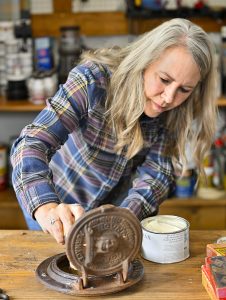
Christen cleans a porthole of a furnace that features a high-profile relief of a Native American chief. After removing loose bits of rust and metal, she seals it using a clear wax. It will become a frame for a small painting in Manitou Galleries’ June group show.
For the show, the artist collected antique board games and little tabletop pinball games, creating paintings on them. “We picked up ’60s tin toy pool tables with real felt tops,” says Vogel. “Then, one day, Christen suggested, ‘Why not do a full-size pool table,’ and after some research to find the right one with cigarette burns that can’t be sanded out, we reworked it into a frame. It will be in the show with a major painting on it.”
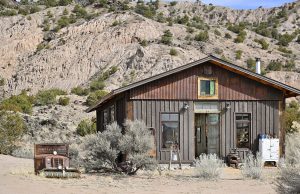
The couple built the studio with help from their sons during the COVID-19 pandemic. The Embudo fault line rises behind the building, and the Embudo Creek is nearby.
Through decades of working side by side, Jim and Christen have built a life rooted in art, craft, and a deep reverence for the culture and character of New Mexico. In their Dixon studio — a space filled with the scent of oil paints and reclaimed wood — they continue to push the boundaries of storytelling through form, texture, and theme, honoring a region rich with memory and meaning.
Shari Morrison has been in the business of art for more than 40 years. She helped found the Scottsdale Artists’ School and the American Women Artists, and directed the Santa Fe Artists’ Medical Fund for some years.
Based in Santa Fe, New Mexico, photographer Daniel Nadelbach’s clients include Smithsonian, Whole Foods, Vogue Australia, Auberge Resorts, and Head Sportswear, among many others.





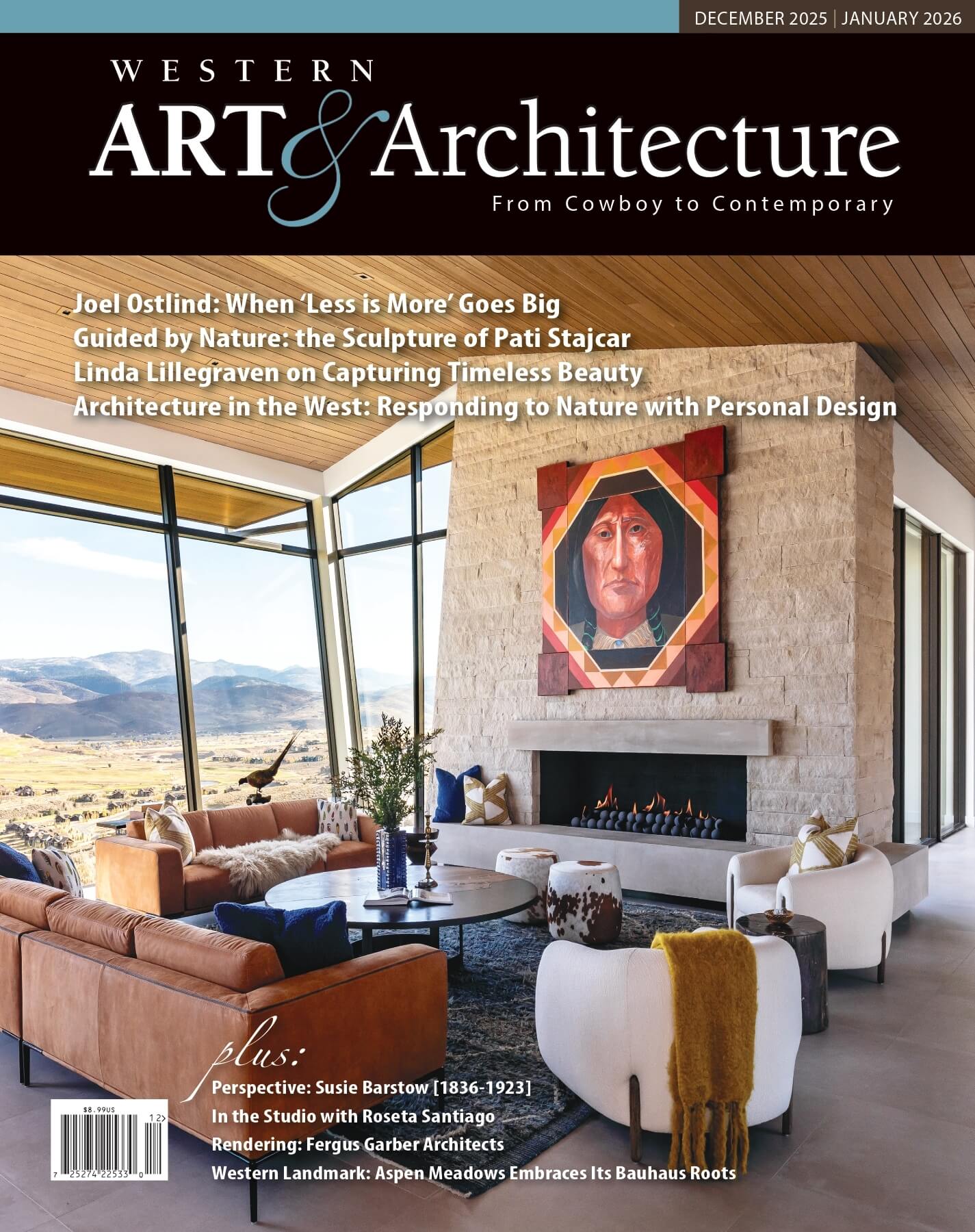
No Comments